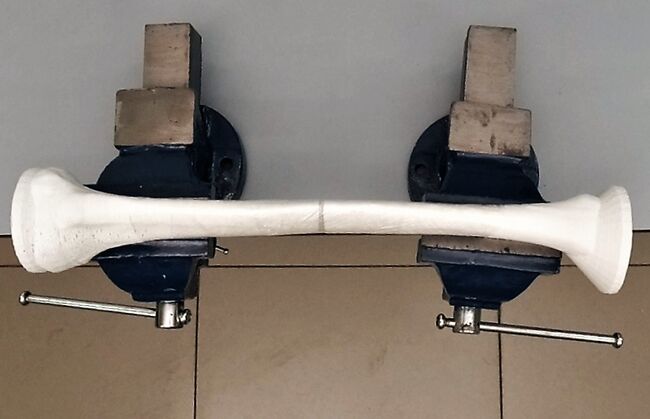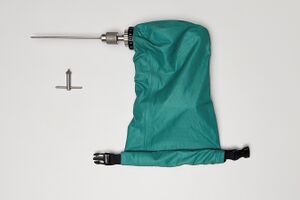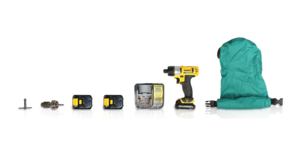
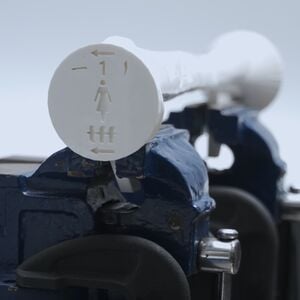
This data-driven, gender-specific, easy to print, environmentally friendly, hygienic, and cruelty-free simulator can be locally made to provide the highest fidelity orthopedic surgical simulation training at the lowest cost in resource-constrained settings. Clear cellophane is wrapped around the slightly distracted 3D printed proximal and distal fracture fragments to simulate the soft tissue envelope and permit visual inspection for targeted self-assessment by the learner. The vise clamps are positioned so the fracture ends are distracted by 2.0 - 3.0 mm but are otherwise properly aligned to simulate a fracture with restored angulation, and rotation.
Materials and Equipment[edit | edit source]
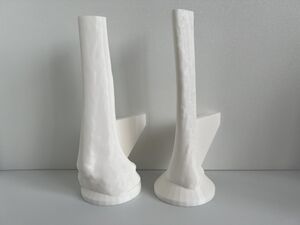
Click on the links below for instructions on how to obtain 3D Printed Adult Tibial Bone Models.
- 3D Printed Adult Male Tibial Bone Models
- 3D Printed Adult Female Tibial Bone Models (under revision)
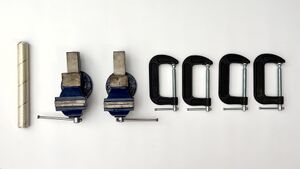
- Clear cellophane
- Vise clamps (minimum 2)
Based on user feedback, we are now recommending learners obtain two 2-in-1 vise clamps instead of two table clamps and four G-clamps to secure the bone models. These 2-in-1 vise clamps are easier to use, cheaper overall ($17 USD/clamp) and can be obtained locally but the delivery times are longer (2 weeks) because they are imported. We will be updating our simulator build video to showcase these 2-in-1 vise clamps soon.
The Arbutus Medical HEX Drill Kit uses autoclavable drill covers to permit faster turnaround on reprocessing orthopedic surgical drills in resource-constrained settings.[1]
Set Up of the Tibial Shaft Transverse Fracture Simulator[edit | edit source]
Assemble and Test Powered Surgical Drill[edit | edit source]
Any powered orthopedic surgical drill that is compatible with 5.0 mm diameter self-drilling Schanz screws can be used for this skills training module.
Obtain the following supplies:
- Powered surgical drill and chuck key (i.e., Arbutus Medical HEX Drill Kit)
- 5.0 mm self-drilling Schanz screw (not shown)
- Follow the surgical drill manufacturer's instructions on how to assemble the surgical drill and insert a 5.0 mm diameter self-drilling Schanz screw using the chuck key.
- If using the Arbutus Medical HEX Drill Kit, follow the video instructions to assemble the Arbutus Medical HEX Drill and insert a 5.0 mm diameter self-drilling Schanz screw.
A sterile person is NOT required to assemble the Arbutus Medical HEX Drill for simulation training.
- If using the Arbutus Medical HEX Drill Kit, push on the forward drilling direction switch on the right side of the drill for clockwise rotation. NOTE: Different drills have different locations for the switch that controls forward drilling direction.
- Test the surgical drill by squeezing the on/off trigger to confirm that the drill is ready for use. The Schanz screw tip should be rotating in a clockwise direction when the Schanz screw tip is pointing away from you.
Acknowledgements[edit | edit source]
This work is funded by a grant from the Intuitive Foundation. Any research, findings, conclusions, or recommendations expressed in this work are those of the author(s), and not of the Intuitive Foundation.
References[edit | edit source]
- ↑ Arbutus Medical. Hex Drill Kit - Orthopedic Surgical Drill [Internet]. Arbutus Medical. Arbutus Medical; 2021 [cited 2021 Nov 28]. Available from: https://arbutusmedical.com/drillcover-hex/.
